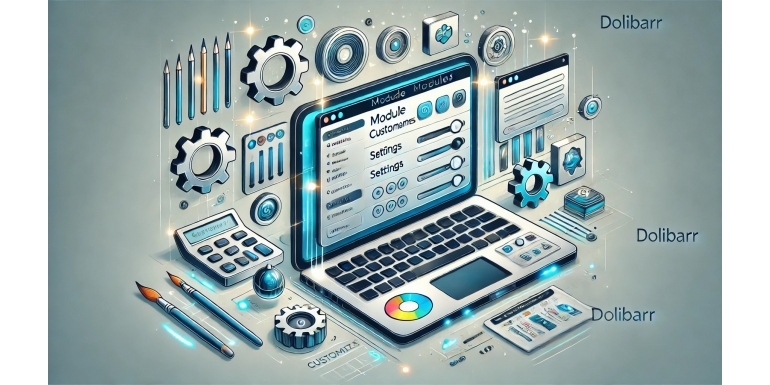
Dolibarr, a popular open-source ERP/CRM software, is a versatile solution tailored to the specific needs of small and medium-sized businesses (SMBs). With its modular structure, users can activate and configure modules to optimize their business operations. However, to fully leverage Dolibarr's potential, customizing the modules is a crucial step.
In this article, we delve into the methods for customizing Dolibarr modules, sharing practical tips, best practices, and concrete examples to adapt Dolibarr to your unique needs. Whether you’re a beginner or an experienced user, this guide will help you make the most of your ERP.
1. Why Customize Dolibarr Modules?
a) Adapting Dolibarr to Your Business Processes
Every business has unique workflows. Customizing modules lets you tailor Dolibarr to your specific processes, whether it’s project management, CRM, or inventory tracking.
b) Enhancing Efficiency
Customization eliminates unnecessary steps, automates tasks, and centralizes your data. This improves team productivity and reduces time spent on administrative work.
c) Meeting Specific Technical Needs
Certain businesses require integrations with other tools, custom fields, or specific calculations. Customizing modules allows you to address these needs without compromising system efficiency.
2. Core Tools for Customizing Dolibarr Modules
Dolibarr provides several built-in tools for module customization. Here’s an overview of the options available:
a) Additional Fields
Additional Fields allow you to add custom fields to existing modules. For example, you can add a field to track specific product reference codes or gather additional customer information.
Configuration:
- Go to Setup > Modules/Applications.
- Activate the Additional Fields module.
- Add fields in the desired module (Customers, Products, Invoices, etc.).
b) Triggers and Hooks
Triggers and hooks let you add actions or modify module behavior without altering Dolibarr's source code.
Example:
- Use a trigger to send an automated email after an invoice is validated.
- Use a hook to modify the appearance of a dashboard.
c) Module Builder
The Module Builder, available on Dolistore, enables users to create custom modules without coding. This tool is ideal for non-technical users who want to add specific functionalities.
3. Key Steps for Customizing a Dolibarr Module
Customizing modules can be done by following these steps:
a) Identify Customization Needs
Before customizing a module, clearly identify your needs:
- Which processes need simplification?
- What information do you need to add or modify?
- What outcomes are you expecting?
b) Configure Existing Modules
Start by exploring Dolibarr’s native configuration options:
- Enable or disable unnecessary features.
- Add additional fields to capture specific data.
- Adjust user permissions for module access.
c) Implement Calculated Fields
Calculated fields allow for automated calculations within Dolibarr. For instance, you can calculate discounts or profit margins automatically in your quotes and invoices.
Example Formula:
To calculate a total with a conditional discount:
4. Advanced Module Customization
For more complex needs, consider these advanced methods:
a) Modify PDF Templates
PDF templates in Dolibarr are widely used for generating quotes, invoices, and other business documents. You can customize these templates to include your logo, contact details, and specific fields.
Steps to Modify a Template:
- Access the PDF template directory in your Dolibarr installation (
htdocs/core/modules). - Select the template to modify (e.g.,
pdf_standard.modules.php). - Edit the file to match your requirements.
b) Use Dolistore Extensions
Dolistore, Dolibarr’s official marketplace, offers pre-built modules to extend core functionalities. You’ll find extensions for payment management, e-commerce integrations, and much more.
Popular Modules:
- Stripe Payment: For online payment integration.
- Advanced Reports: For detailed and customizable reports.
- Project Gantt Chart: For advanced project management.
c) Develop Custom Modules
If existing tools don’t meet your needs, you can develop your own modules. Dolibarr provides comprehensive developer documentation to facilitate the creation of new functionalities.
5. Tips to Maximize Customization
a) Maintain a Clear Structure
Document every modification for future maintenance. This includes a list of added fields, used formulas, and modified files.
b) Test Before Deployment
Test your customizations in a staging environment to prevent disruptions in daily operations.
c) Involve Your Team
Engage your teams in the customization process to ensure that changes meet their needs.
d) Leverage Community Resources
Join Dolibarr forums and consult the official documentation for advice and solutions to challenges.
6. Case Studies: Successful Customization in Dolibarr
a) Case Study 1: Optimizing Project Management
A service company customized the project management module to track tasks by department. They added fields for allocated budgets and used custom PDF templates to generate professional project reports.
b) Case Study 2: E-Commerce Integration
An online retailer used a Dolistore module to connect their WooCommerce site to Dolibarr, automatically syncing orders, inventory, and customer data.
7. Best Practices for Module Customization
a) Prioritize Simplicity
Avoid overloading your system with unnecessary customizations. Focus on what adds value to your business.
b) Stay Updated
Dolibarr evolves regularly. Keep your system updated to benefit from the latest features and security patches.
c) Use Backups
Always back up your data and files before modifying modules to prevent data loss in case of errors.
8. The Future of Customization in Dolibarr
In the future, Dolibarr will continue enhancing its customization capabilities, including:
- Simplified user interfaces for module configuration.
- Closer integration with AI tools to further automate tasks.
- An expanded community offering even more modules on Dolistore.
9. Conclusion
Customizing Dolibarr modules is essential to unlocking the full potential of this open-source ERP. Whether you’re adding additional fields, modifying PDF templates, or developing your own modules, the possibilities are endless.
By following the tips and best practices outlined in this article, you can tailor Dolibarr to your unique needs, improve the efficiency of your processes, and deliver a better user experience for your teams.
Ready to customize your Dolibarr? Get started today and transform your ERP into a tool perfectly adapted to your business!
